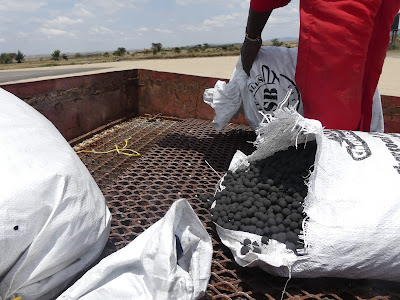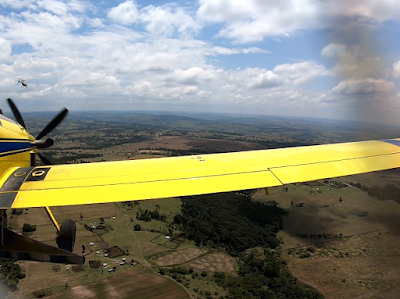Spreaders are attached to agricultural aircraft and used to
distribute seeds, fertilizers and dry chemical products. The
first time an airplane was used to treat crops was in 1921
when a U.S. Army pilot applied insecticide to Ohio’s catalpa
trees infested with moth. Since then, agricultural aviation has
proven to be a fast and efficient form of product application
to our crops.

The most common spreader used in agricultural aviation
in the United States is the venturi or RAM spreader. Venturi
spreaders clamp to the gate box at the base of the aircraft’s
hopper. The gate boxes are 25, 38 or 41 inches wide depending on the size of the aircraft. As the adjustable door (gate) on
the gate box opens, material from the hopper falls into the
venturi spreader, and it is distributed by the airflow through
the spreader. The opening of the door determines the flow
rate. Some of the limitations on venturi spreaders include high
aerodynamic drag, high power requirements and low quality
pattern of distribution for high application rates (greater than
250 pounds per acre).


The venturi spreader is composed of ducts, also called vanes
that can vary in number from five to 13. Each vane has adjustable sections at the front or rear. Adjustments on the front
portion of the vane modifies the amount of material and air
that moves through it. Adjustments of the rear section of the
vanes may change the initial path of the material leaving the
spreader.
As an aerial applicator your job is to deliver product (fertilizer, seeds, etc.) on time, with great quality and precision.
Major concerns to applicators are swath width, uniformity and
operation efficiency. How the spreader is mounted (attitude), the rate of application and variations in the material’s physical
properties have major effects on swath width and uniformity
of application. Larger swath widths will increase operation
efficiency (acres per hour), a “must-do” today with the increasing operational costs.
Variable-rate application (VRA) is a technique often used
by progressive farmers in which different product rates are
applied in the field in an attempt to match varying field
requirements according to features such as soil type or field
topography. Farmers and agricultural consultants work together to develop variable-rate maps. Computerized systems
for variable-rate application of dry material are available for
agricultural airplanes.
These systems automatically adjust gate
opening during flight, releasing more or less material according to a prescription map, ground coordinates and aircraft
speed. The system also can be used to adjust material release
based on aircraft ground speed, offering a precise single-rate
application. VRA may be a great option for farmers wishing to
apply precision-farming technology to their fields, and it may
offer aerial applicators the opportunity to add value to their
services, therefore enhancing their level of customer service.
With credit to
https://aerialspray.co.za/ewExternalFiles/pub3078SpreaderSetupforAerialLOWRES.pdf and Farmland Aviation Kenya.






















































